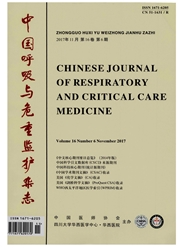

 中文摘要:
中文摘要:
目的调查陕西省地区级城市哮喘患者的控制现状和对疾病的认知程度。方法在陕西省的6个地区级城市中共选择8所三级医院,以面对面问卷形式对2007年10月至12月门诊哮喘患者(≥14岁)进行调查。结果收回调查问卷523份。结果显示:①哮喘控制情况:自我评判控制水平显示控制、部分控制和未控制分别26.4%、52.4%和11.1%。48%患者规律使用吸人性糖皮质激素(ICS)。哮喘控制测试(ACT)平均得分17.88±4.43。②药物治疗情况:每日使用药物前三位的分别是ICS(26.6%)、口服缓释茶碱(25.2%)及ICS联合长效B:受体激动剂(21.8%)。12.6%的患者未使用药物,5.2%的患者使用中药、抗生素等非常规药物。③哮喘发作征兆的感知和自我管理:58.3%患者认为病情恶化时最大的影响是限制或停止运动和日常活动,9.8%和52.6%的患者对自己控制恶化非常有或有信心。68.6%哮喘发作时有征兆,最常见的症状是喷嚏咽痒、胸喉部发紧、咳嗽。④疾病的认知程度:73.6%认同哮喘是一种气道炎症性疾病。对于持续期哮喘,33.3%认为应将ICS作为首选一线药物。只有32.1%参加过医院举办的哮喘防治知识讲座。结论经过陕西省哮喘协作组各成员单位1年余的宣教活动,城区哮喘患者的疾病控制现状与认知程度还有一定缺欠,距离完全控制仍任重道远。
 英文摘要:
英文摘要:
Objective To evaluate the control status and knowledge level about disease in asthmatic patients in region level cities of Shaanxi province for effect appraisal of patient education. Methods Eight hospitals were selected from six region level cities, where questionnaire survey was completed in out-patients with asthma ( ≥ 14 years old). Results A total of 523 patients completed the questionnaire with a ratio of male to female of 1: 1.14,and an average age of (44. 3 ± 15.5) years old. The percentage of controlled, partly controlled and uncontrolled by self-evaluation was respectively 26. 4% ,52.4% and 11.1%. 48% insisted on using inhaled corticosteroids (ICS). The average score was 17.88±4.43 by asthma control test (ACT). The first three medicines used daily were ICS (26. 6% ) , sustained-release theophyline (25.2%) and combination ICS/long-acting β2-agonists (21.8%). 12. 6% had no medicine and 5.2% used non- orthodox medicines. 68.6% patients had omen before exacerbation,and those were sneezing, chest distress and cough. 73.6% knew asthma is a disease of airway inflammation,and 33.30/o selected ICS as the leader medicine. Only 32. 1% attended the lecture about asthma in hospitals and 85.0% longed for such education. Conclusions The control status and knowledge level about disease in asthmatic patients in cities still need to be improved in Shaanxi province, and too much work need to be done in order to realize the total control in all patients.
 同期刊论文项目
同期刊论文项目
 同项目期刊论文
同项目期刊论文
 期刊信息
期刊信息
